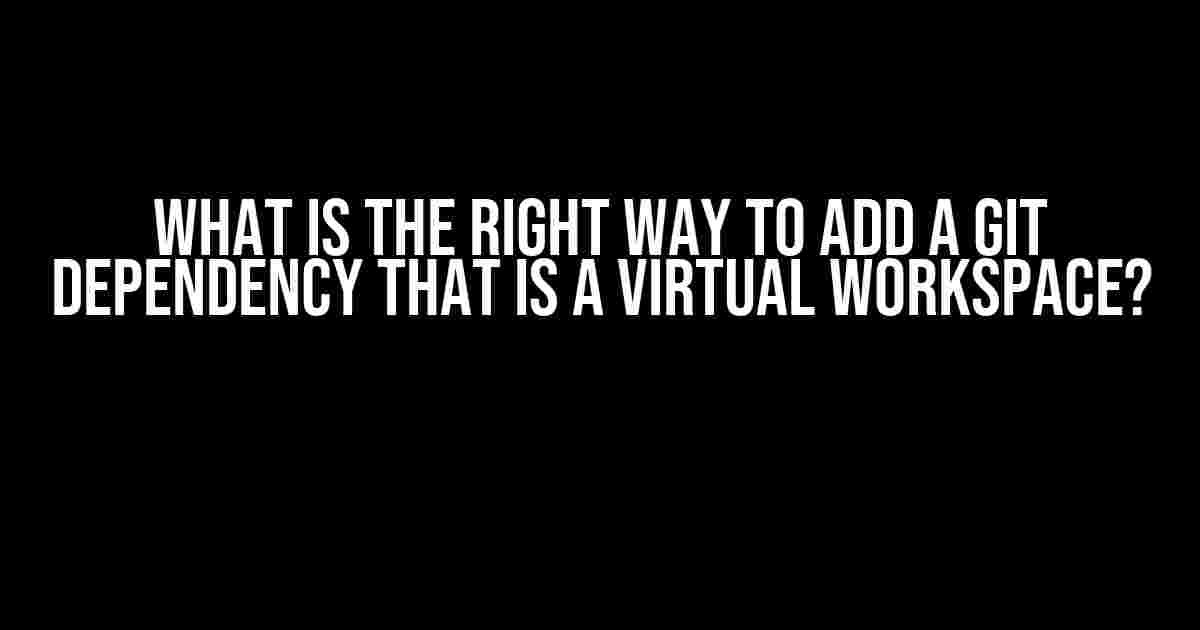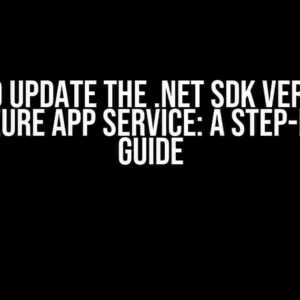Are you tired of struggling with Git dependencies that are also virtual workspaces? Do you find yourself lost in a sea of confusing documentation and Stack Overflow threads? Fear not, dear developer, for we’re about to dive into the depths of Git dependency management and emerge victorious on the other side!
The Problem with Virtual Workspaces
Virtual workspaces, also known as monorepos, are becoming increasingly popular in the development community. They allow multiple projects to share a common codebase, making it easier to manage dependencies and share code. However, when it comes to adding a Git dependency that is itself a virtual workspace, things can get hairy.
The issue lies in the fact that virtual workspaces often have their own dependency management systems, which can conflict with your project’s dependencies. This can lead to versioning nightmares, circular dependencies, and a whole lot of frustration.
The Wrong Way to Add a Git Dependency
Before we dive into the right way to add a Git dependency that is a virtual workspace, let’s take a look at some common mistakes to avoid:
git submodule addwith a virtual workspace as the submodule. This can lead to versioning conflicts and make it difficult to manage dependencies.- Adding the virtual workspace as a dependency in your
package.jsonfile without specifying the correct version or commit. This can lead to unexpected behavior and version conflicts. - Using a Git alias or shortcut to reference the virtual workspace. This can make it difficult to track changes and manage dependencies.
The Right Way to Add a Git Dependency
So, how do you add a Git dependency that is a virtual workspace the right way? Follow these steps:
Step 1: Identify the Virtual Workspace
First, identify the virtual workspace you want to add as a dependency. Make a note of its Git repository URL and the specific branch or commit you want to use.
Step 2: Create a Git Remote
Create a new Git remote that points to the virtual workspace repository. You can do this by running the following command:
git remote add virtual-workspace https://github.com/username/virtual-workspace.gitStep 3: Fetch the Virtual Workspace
Fetch the virtual workspace repository to get the latest code:
git fetch virtual-workspaceStep 4: Create a Git Submodule
Create a new Git submodule that references the virtual workspace. You can do this by running the following command:
git submodule add -b main virtual-workspace path/to/virtual-workspaceReplace main with the specific branch or commit you want to use, and path/to/virtual-workspace with the desired path for the submodule.
Step 5: Update the Git Submodule
Update the Git submodule to use the latest code from the virtual workspace:
git submodule update --init --recursiveStep 6: Add the Dependency to Your Project
Finally, add the virtual workspace as a dependency to your project. You can do this by adding the following line to your package.json file:
"dependencies": {
"virtual-workspace": "github:username/virtual-workspace#main"
}Replace github:username/virtual-workspace#main with the correct repository URL and branch or commit.
Managing Dependencies with a Virtual Workspace
Once you’ve added the virtual workspace as a dependency, you’ll need to manage its dependencies as well. Here are some tips to keep in mind:
- Use a consistent versioning strategy for both your project and the virtual workspace.
- Use a dependency management tool like Lerna or Yarn Workspaces to manage dependencies across multiple projects.
- Keep the virtual workspace up-to-date by regularly fetching and updating the submodule.
- Use a CI/CD pipeline to automate dependency management and testing.
Conclusion
Adding a Git dependency that is a virtual workspace requires careful planning and execution. By following the steps outlined above, you can avoid common pitfalls and ensure that your dependencies are managed correctly. Remember to keep your dependencies up-to-date, use consistent versioning, and automate dependency management with a CI/CD pipeline.
With these tips and tricks, you’ll be well on your way to managing complex dependencies like a pro! So go ahead, take the leap, and add that virtual workspace as a dependency – the right way!
| Git Command | Description |
|---|---|
git remote add |
Add a new Git remote |
git fetch |
Fetch the latest code from a Git repository |
git submodule add |
Add a new Git submodule |
git submodule update |
Update a Git submodule to the latest code |
By following these steps and tips, you’ll be able to add a Git dependency that is a virtual workspace with confidence. Remember to stay organized, keep your dependencies up-to-date, and automate as much as possible. Happy coding!
Frequently Asked Question
Get the lowdown on adding a Git dependency that’s a virtual workspace!
What’s the deal with adding a Git dependency that’s a virtual workspace?
When you add a Git dependency that’s a virtual workspace, you’re essentially telling Git to treat the dependency as a separate project with its own Git repository. This allows you to manage the dependency independently, making it easier to update and maintain. Think of it like having a mini Git repo within your main project!
How do I add a Git dependency that’s a virtual workspace to my project?
To add a Git dependency that’s a virtual workspace, you’ll need to create a Git submodule. This involves adding a `.gitmodules` file to your project, specifying the dependency’s Git repository and the path where you want to store it. Then, run `git submodule init` and `git submodule update` to download the dependency and set it up as a virtual workspace. Easy peasy!
What’s the difference between a Git submodule and a Git dependency?
A Git submodule is a Git repository within another Git repository, whereas a Git dependency is simply a library or project that your project relies on. When you add a Git dependency as a virtual workspace, you’re essentially creating a Git submodule that allows you to manage the dependency independently. Think of a Git submodule as a container for your Git dependency!
Can I update my Git dependency that’s a virtual workspace?
Absolutely! Since your Git dependency is a virtual workspace, you can update it just like you would update a regular Git repository. You can pull changes from the dependency’s remote repository, commit changes locally, or even push changes back to the remote repository. The beauty of having a virtual workspace is that you have full control over the dependency’s lifecycle!
What happens if I delete my Git dependency that’s a virtual workspace?
If you delete your Git dependency that’s a virtual workspace, you’ll remove the entire dependency from your project. This means that any changes you made to the dependency will be lost, and you’ll need to recreate the dependency or restore it from a backup. However, since it’s a virtual workspace, you can always recreate the dependency by running `git submodule update` again. Phew!


